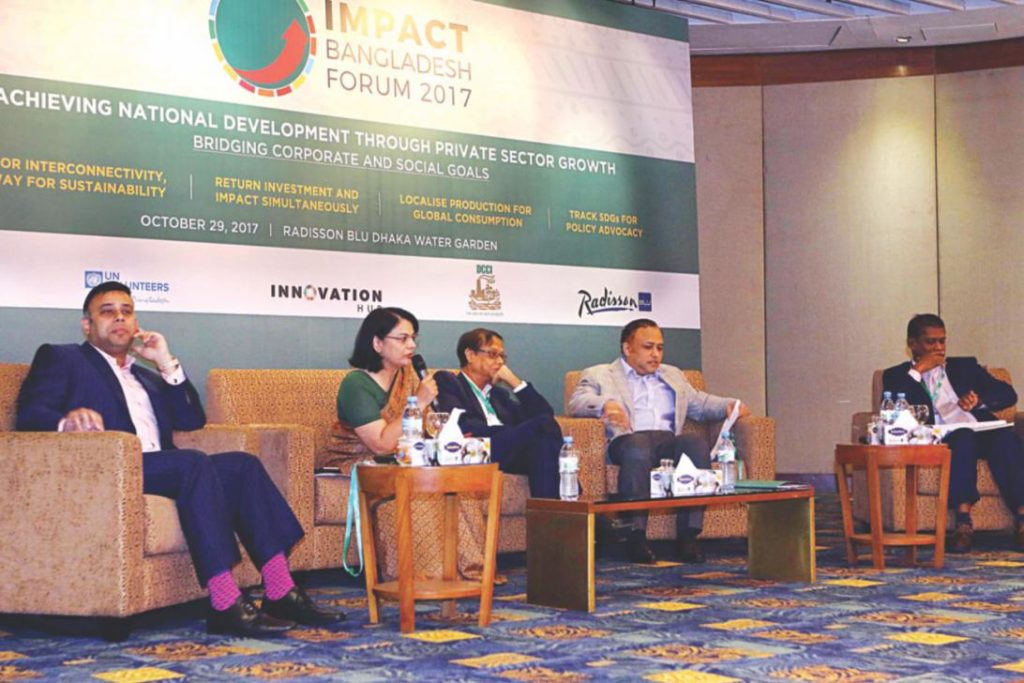Published in The Daily Star on October 30, 2017

Photo: The Daily Star
Bangladesh needs to increase allocation for infrastructure development by more than 3.5 times from its current annual spending of $3.5 billion if it wants to benefit from regional and international connectivity, experts said yesterday.
The idea that only the government should develop and maintain the infrastructure needs to be changed.
“The private sector should also participate in the development of infrastructure,” said Syed Afsor H Uddin, chief executive officer of PPP (public-private partnership) Office.
In Bangladesh, the government accounts for 90 percent of the infrastructure spending and the private sector only 10 percent.
“That has to be changed,” Afsor said while presenting a keynote paper at a seminar on ‘building infrastructure for growth and SDGs’, jointly organised by the Dhaka Chamber of Commerce and Industry and the United Nations Development Programme on the sidelines of the daylong Impact Bangladesh Forum.
It is feasible for the private sector to develop airports and other ports.
Similarly, the potential of the private sector can also be utilised in education and health sectors, Afsor said at the event held at the capital’s Radisson Hotel.
The government should spend at least 5 percent of the total budget on the development of infrastructure if it is not possible to spend 10 percent, which is the standard, said Selim Raihan, professor of the University of Dhaka’s economics department.
The Bangladesh government should take a lot of initiatives to be integrated into the Bangladesh, Bhutan, India and Nepal (BBIN) corridor and China’s Belt and Road Initiative.
He also suggested wholesale reforms of the country’s trade policies, which he said have become dated now.
The country’s target of exporting $50 billion worth of garment items by 2020 might not be possible without resolving the domestic supply chain challenges, said Mahbubul Anam, president of Bangladesh Freight Forwarders Association.
For instance, exporters and importers have to wait for seven days for the release of their goods at the Dhaka airport; it takes on average 21 days to release imported goods from Benapole land port, he said.
“The physical infrastructure should be improved by the private sector.”
Anam also touched upon the lack of trading activities among the Saarc nations. Trade between the Saarc nations is only 5 percent, whereas it is 26 percent among the Asean nations.
Neither the coastal shipping line agreement with India nor the BBIN could be made functional as those were done without adequate consultation with the stakeholders. “So, there are a lot of barriers to regional connectivity.”
He also called for a national single window from where entrepreneurs can get all the necessary documents within 24 or 48 hours. Without having such a facility, the businessmen have to collect 22 permissions for running a business, Anam added.
Khan Ahmed Sayeed Murshid, director general of the Bangladesh Institute of Development Studies, moderated the seminar.
In another session, Ahsan H Mansur, executive director of the Policy Research Institute, said while the idea of having 100 special economic zones in the near future is heartening, one must temper the expectations given the bad examples of Korean EPZ, Kaliakoir IT Park and leather estate in Savar.
The authority of Korean EPZ is facing challenges in land registration; the Kaliakoir IT Park is ready but it is not operational yet; and the leather estate in Savar is running but the effluent treatment plant is not functioning properly. “The government must learn from these incidents.”
Mansur also called for a stable energy policy as both the local and foreign investors want to have a reliable source of power at stable rates to run their business. “Economic governance is also necessary as the country’s banking system is not going in the right direction.”
Bangladesh needs to capitalise on the opportunities stemming from the economic developments in India, China and Japan, he said.
“The current Rohingya issue indicates that Bangladesh is isolated in this region. We are isolated, because of our own problems. We are not connected enough. We need to have a strong geo-political connectivity,” Mansur added.
Economic zones employ 13 percent of Dubai’s workforce, said Masrur Reaz, senior economist and programme manager of Trade and Competitiveness Global Practice of the World Bank, while highlighting the contribution of economic zones around the world.
Particularly in China, economic zones contributed 11.1 percent to its gross domestic product and created 19 million jobs.
Economic zones utilised 9.5 percent of China’s total foreign direct investment, he said, adding that such zones in China accounted for 37 percent of Chinese merchandise export in a year.
The economic zones in Bangladesh can help achieve 7.4 percent GDP growth and export $54.1 billion worth of goods in a year, Reaz added.
ASM Mainuddin Monem, deputy managing director of Abdul Monem Ltd, said Japanese firm Honda is setting up a factory in the economic zone owned by his company.
Nihad Kabir, president of the Metropolitan Chamber of Commerce and Industry, moderated the session.
 CPD RMG Study Stitching a better future for Bangladesh
CPD RMG Study Stitching a better future for Bangladesh



